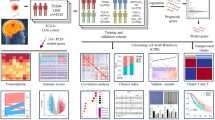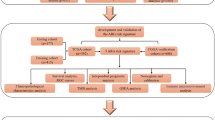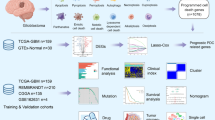Abstract
The growth of cancer, the effectiveness of treatment, and prognosis are all closely related to PANoptosis (include pyroptosis, apoptosis, and necroptosis). It remains unclear whether PANoptosis genes (PANGs) may contribute to lower-grade glioma (LGG) tumor microenvironment (TME). In this study, we collected 1203 LGG samples from three public databases and reported that PANoptosis involves TME interaction and prognosis. Firstly, we provided a comprehensive review of the pan-cancer landscape of PANGs in terms of expression characteristics, prognostic value, mutational profile, and pathway regulation. Then, we identified two distinct PANclusters, each with its own molecular, clinical, and immunological profile. We then developed a scoring system for LGG patients called PANscore. As well as investigating immune characteristics, tumor mutational characteristics, and drug sensitivity, we examined the differences between groups with high PANscores and those with low PANscores. Based on this PANscore and clinicopathological variables, an instant nomogram for predicting clinical survival in LGG patients was developed. Our thorough examination of PANGs in LGG revealed their probable function in TME, as well as their clinicopathological characteristics and prognosis. These discoveries could deepen our comprehension of PANGs in LGG and provide doctors fresh perspectives on how to forecast prognosis and create more efficient, individualized treatment plans.













Similar content being viewed by others
Data availability
The original contributions presented in the study are included in the article and further enquiries can be directed to the corresponding author.
Change history
11 May 2024
This article has been retracted. Please see the Retraction Notice for more detail: https://doi.org/10.1007/s10142-024-01374-3
References
Aguila B, Morris AB, Spina R, Bar E, Schraner J, Vinkler R, Sohn JW, Welford SM (2019) The Ig superfamily protein PTGFRN coordinates survival signaling in glioblastoma multiforme. Cancer Lett 462:33–42
Barrett T, Troup DB, Wilhite SE, Ledoux P, Evangelista C, Kim IF, Tomashevsky M, Marshall KA, Phillippy KH, Sherman PM, Muertter RN, Holko M, Ayanbule O, Yefanov A, Soboleva A (2011) NCBI GEO: archive for functional genomics data sets--10 years on. Nucleic Acids Res 39:D1005–D1010
Barth ND, Subiros-Funosas R, Mendive-Tapia L, Duffin R, Shields MA, Cartwright JA, Henriques ST, Sot J, Goñi FM, Lavilla R, Marwick JA, Vermeren S, Rossi AG, Egeblad M, Dransfield I, Vendrell M (2020) A fluorogenic cyclic peptide for imaging and quantification of drug-induced apoptosis. Nat Commun 11:4027
Chen F, Zhuang X, Lin L, Yu P, Wang Y, Shi Y, Hu G, Sun Y (2015) New horizons in tumor microenvironment biology: challenges and opportunities. BMC Med 13:45
Chen X, Chen H, Yao H, Zhao K, Zhang Y, He D, Zhu Y, Cheng Y, Liu R, Xu R, Cao K (2021) Turning up the heat on non-immunoreactive tumors: pyroptosis influences the tumor immune microenvironment in bladder cancer. Oncogene 40:6381–6393
Feng J, Zhang Y, Ren X, Li D, Fu H, Liu C, Zhou W, Liu Q, Liu Q, Wu M (2020) Leucine-rich repeat containing 4 act as an autophagy inhibitor that restores sensitivity of glioblastoma to temozolomide. Oncogene 39:4551–4566
Feng S, Xia T, Ge Y, Zhang K, Ji X, Luo S, Shen Y (2022a) Computed tomography imaging-based radiogenomics analysis reveals hypoxia patterns and immunological characteristics in ovarian cancer. Front Immunol 13:868067
Feng S, Xu Y, Dai Z, Yin H, Zhang K, Shen Y (2022b) Integrative analysis from multicenter studies identifies a WGCNA-derived cancer-associated fibroblast signature for ovarian cancer. Front Immunol 13:951582
Goenaga AL, Zhou Y, Legay C, Bougherara H, Huang L, Liu B, Drummond DC, Kirpotin DB, Auclair C, Marks JD, Poul MA (2007) Identification and characterization of tumor antigens by using antibody phage display and intrabody strategies. Mol Immunol 44:3777–3788
Guilmain W, Colin S, Legrand E, Vannier JP, Steverlynck C, Bongaerts M, Vasse M, Al-Mahmood S (2011) CD9P-1 expression correlates with the metastatic status of lung cancer, and a truncated form of CD9P-1, GS-168AT2, inhibits in vivo tumour growth. Br J Cancer 104:496–504
Huang R, Li Z, Zhu X, Yan P, Song D, Yin H, Hu P, Lin R, Wu S, Meng T, Zhang J, Huang Z (2020) Collagen Type III Alpha 1 chain regulated by GATA-Binding Protein 6 affects Type II IFN response and propanoate metabolism in the recurrence of lower grade glioma. J Cell Mol Med 24:10803–10815
Jiang W, Deng Z, Dai X, Zhao W (2021) PANoptosis: a new insight into oral infectious diseases. Front Immunol 12:789610
Karki R, Sharma BR, Lee E, Banoth B, Malireddi RKS, Samir P, Tuladhar S, Mummareddy H, Burton AR, Vogel P, Kanneganti TD (2020) Interferon regulatory factor 1 regulates PANoptosis to prevent colorectal cancer. JCI insight 5
Karki R, Sharma BR, Tuladhar S, Williams EP, Zalduondo L, Samir P, Zheng M, Sundaram B, Banoth B, Malireddi RKS, Schreiner P, Neale G, Vogel P, Webby R, Jonsson CB, Kanneganti TD (2021) Synergism of TNF-α and IFN-γ triggers inflammatory cell death, tissue damage, and mortality in SARS-CoV-2 infection and cytokine shock syndromes. Cell 184:149–168.e17
Kim S, Burette A, Chung HS, Kwon SK, Woo J, Lee HW, Kim K, Kim H, Weinberg RJ, Kim E (2006) NGL family PSD-95-interacting adhesion molecules regulate excitatory synapse formation. Nat Neurosci 9:1294–1301
Kolesnikova TV, Kazarov AR, Lemieux ME, Lafleur MA, Kesari S, Kung AL, Hemler ME (2009) Glioblastoma inhibition by cell surface immunoglobulin protein EWI-2, in vitro and in vivo. Neoplasia 11:77–86 4p following 86
Lee S, Karki R, Wang Y, Nguyen LN, Kalathur RC, Kanneganti TD (2021) AIM2 forms a complex with pyrin and ZBP1 to drive PANoptosis and host defence. Nature 597:415–419
Lemasson B, Chenevert TL, Lawrence TS, Tsien C, Sundgren PC, Meyer CR, Junck L, Boes J, Galbán S, Johnson TD, Rehemtulla A, Ross BD, Galbán CJ (2013) Impact of perfusion map analysis on early survival prediction accuracy in glioma patients. Transl Oncol 6:766–774
Li P, Feng J, Liu Y, Liu Q, Fan L, Liu Q, She X, Liu C, Liu T, Zhao C, Wang W, Li G, Wu M (2017) Novel Therapy for glioblastoma multiforme by restoring LRRC4 in tumor cells: LRRC4 inhibits tumor-infitrating regulatory T cells by cytokine and programmed cell death 1-containing exosomes. Front Immunol 8:1748
Louis DN, Perry A, Wesseling P, Brat DJ, Cree IA, Figarella-Branger D, Hawkins C, Ng HK, Pfister SM, Reifenberger G, Soffietti R, von Deimling A and Ellison DW (2021) The 2021 WHO classification of tumors of the central nervous system: a summary. Neuro-oncology 23:1231-1251
Mala U, Baral TK, Somasundaram K (2022) Integrative analysis of cell adhesion molecules in glioblastoma identified prostaglandin F2 receptor inhibitor (PTGFRN) as an essential gene. BMC Cancer 22:642
Malireddi RKS, Karki R, Sundaram B, Kancharana B, Lee S, Samir P, Kanneganti TD (2021) Inflammatory cell death, panoptosis, mediated by cytokines in diverse cancer lineages inhibits tumor growth. ImmunoHorizons 5:568–580
Malireddi RKS, Kesavardhana S, Kanneganti TD (2019) ZBP1 and TAK1: master regulators of NLRP3 inflammasome/pyroptosis, apoptosis, and necroptosis (PAN-optosis). Front Cell Infect Microbiol 9:406
Morimoto-Tomita M, Uchimura K, Bistrup A, Lum DH, Egeblad M, Boudreau N, Werb Z, Rosen SD (2005) Sulf-2, a proangiogenic heparan sulfate endosulfatase, is upregulated in breast cancer. In: Neoplasia, vol 7, (New York, N.Y.), pp 1001–1010
Nawroth R, van Zante A, Cervantes S, McManus M, Hebrok M, Rosen SD (2007) Extracellular sulfatases, elements of the Wnt signaling pathway, positively regulate growth and tumorigenicity of human pancreatic cancer cells. PLoS One 2:e392
Ostrom QT, Gittleman H, Truitt G, Boscia A, Kruchko C, Barnholtz-Sloan JS (2018) CBTRUS statistical report: primary brain and other central nervous system tumors diagnosed in the United States in 2011-2015. Neuro-oncology 20:iv1-iv86
Pan H, Pan J, Li P, Gao J (2022) Characterization of PANoptosis patterns predicts survival and immunotherapy response in gastric cancer. Clin Immunol 238:109019
Phillips JJ, Huillard E, Robinson AE, Ward A, Lum DH, Polley MY, Rosen SD, Rowitch DH, Werb Z (2012) Heparan sulfate sulfatase SULF2 regulates PDGFRα signaling and growth in human and mouse malignant glioma. J Clin Invest 122:911–922
Song W, Ren J, Xiang R, Kong C, Fu T (2021) Identification of pyroptosis-related subtypes, the development of a prognosis model, and characterization of tumor microenvironment infiltration in colorectal cancer. Oncoimmunology 10:1987636
Tomczak K, Czerwińska P, Wiznerowicz M (2015) The Cancer Genome Atlas (TCGA): an immeasurable source of knowledge. Contemp Oncol 19:A68–A77
Wade A, Robinson AE, Engler JR, Petritsch C, James CD, Phillips JJ (2013) Proteoglycans and their roles in brain cancer. FEBS J 280:2399–2417
Wang Y, Kanneganti TD (2021) From pyroptosis, apoptosis and necroptosis to PANoptosis: A mechanistic compendium of programmed cell death pathways. Comput Struct Biotechnol J 19:4641–4657
Wang Y, Zhao W, Liu X, Guan G, Zhuang M (2019) ARL3 is downregulated and acts as a prognostic biomarker in glioma. J Transl Med 17:210
Woo J, Kwon SK, Choi S, Kim S, Lee JR, Dunah AW, Sheng M, Kim E (2009) Trans-synaptic adhesion between NGL-3 and LAR regulates the formation of excitatory synapses. Nat Neurosci 12:428–437
Xu G, Wang R, Wang Z, Lei Q, Yu Z, Liu C, Li P, Yang Z, Cheng X, Li G, Wu M (2015) NGL-2 is a new partner of PAR complex in axon differentiation. J Neurosci 35:7153–7164
Xu Y, Wang Z, Wang J, Li J, Wang H, Yue W (2010) Lentivirus-mediated knockdown of cyclin Y (CCNY) inhibits glioma cell proliferation. Oncol Res 18:359–364
Yan WT, Yang YD, Hu XM, Ning WY, Liao LS, Lu S, Zhao WJ, Zhang Q, Xiong K (2022) Do pyroptosis, apoptosis, and necroptosis (PANoptosis) exist in cerebral ischemia? Evidence from cell and rodent studies. Neural Regen Res 17:1761–1768
Yan WT, Zhao WJ, Hu XM, Ban XX, Ning WY, Wan H, Zhang Q, Xiong K (2023) PANoptosis-like cell death in ischemia/reperfusion injury of retinal neurons. Neural Regen Res 18:357–363
Yang C, Zhang H, Chen M, Wang S, Qian R, Zhang L, Huang X, Wang J, Liu Z, Qin W, Wang C, Hang H, Wang H (2022) A survey of optimal strategy for signature-based drug repositioning and an application to liver cancer. eLife 11
Ye Y, Dai Q, Qi H (2021) A novel defined pyroptosis-related gene signature for predicting the prognosis of ovarian cancer. Cell Death Dis 7:71
Ye Y, Xiang Y, Ozguc FM, Kim Y, Liu CJ, Park PK, Hu Q, Diao L, Lou Y, Lin C, Guo AY, Zhou B, Wang L, Chen Z, Takahashi JS, Mills GB, Yoo SH, Han L (2018) The genomic landscape and pharmacogenomic interactions of clock genes in cancer chronotherapy. Cell systems 6:314–328.e2
Zeng WJ, Yang YL, Liu ZZ, Wen ZP, Chen YH, Hu XL, Cheng Q, Xiao J, Zhao J, Chen XP (2018) Integrative analysis of DNA methylation and gene expression identify a three-gene signature for predicting prognosis in lower-grade gliomas. Cell Physiol Biochem 47:428–439
Zhao Z, Zhang KN, Wang Q, Li G, Zeng F, Zhang Y, Wu F, Chai R, Wang Z, Zhang C, Zhang W, Bao Z, Jiang T (2021) Chinese Glioma Genome Atlas (CGGA): a comprehensive resource with functional genomic data from Chinese glioma patients. Genom Proteom Bioinform 19:1–12
Zheng M, Kanneganti TD (2020) The regulation of the ZBP1-NLRP3 inflammasome and its implications in pyroptosis, apoptosis, and necroptosis (PANoptosis). Immunol Rev 297:26–38
Zhou C, Cunningham L, Marcus AI, Li Y, Kahn RA (2006) Arl2 and Arl3 regulate different microtubule-dependent processes. Mol Biol Cell 17:2476–2487
Funding
This work was supported by the Xinjiang Key Laboratory of Neurological Disorder Research (grant number: XJDX1711-2202).
Author information
Authors and Affiliations
Contributions
AA, AM: the study’s design, data analysis, and article writing were all completed. NY, QF, SL, YL: checked the text and assisted with data analysis and collation. YW, QZ: reviewed and revised the manuscript. The article’s submission was reviewed and approved by all authors.
Corresponding authors
Ethics declarations
Competing interests
The authors declare no competing interests.
Additional information
Publisher’s note
Springer Nature remains neutral with regard to jurisdictional claims in published maps and institutional affiliations.
This article has been retracted. Please see the retraction notice for more detail:https://doi.org/10.1007/s10142-024-01374-3
Supplementary information
Rights and permissions
Springer Nature or its licensor (e.g. a society or other partner) holds exclusive rights to this article under a publishing agreement with the author(s) or other rightsholder(s); author self-archiving of the accepted manuscript version of this article is solely governed by the terms of such publishing agreement and applicable law.
About this article
Cite this article
Abulaiti, A., Maimaiti, A., Yiming, N. et al. RETRACTED ARTICLE: Molecular subtypes based on PANoptosis-related genes and tumor microenvironment infiltration characteristics in lower-grade glioma. Funct Integr Genomics 23, 84 (2023). https://doi.org/10.1007/s10142-023-01003-5
Received:
Revised:
Accepted:
Published:
DOI: https://doi.org/10.1007/s10142-023-01003-5




